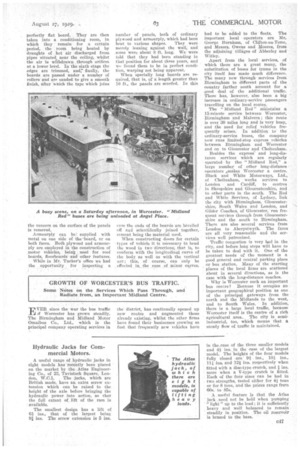PLYWOOD FOR BUS BODIES.
Page 68

Page 69

If you've noticed an error in this article please click here to report it so we can fix it.
Some Information on the Use and Manufacture of Tucker's Plywood, which is Largely Used for Passenger Vehicles.
IN view of the article dealing with Ithe subject of plywood which was published in our issue dated June 25th, it is interesting to refer to the general features of the products of Tucker Armoured Plywood Co., Ltd., Creek Mill Ply Works, Crayford, Kent, and to the methods of construction which are employed by the company. This concern has a large store of many classes of wood, which include Canadian birch, beech, oak, mahogany, walnut, bird's-eye maple, etc., thus enabling orders to be speedily executed.
It also has large stocks of metal for employment in connection with the con struction of armoured plywood. This store consists of galvanized-steel sheets, black-steel sheets, zinc, copper, aluminium, duralumin and bronze.
In the first stage of preparation the log is boiled to soften it, subsequently being barked and peeled. It is then put into a lathe and the veneers are cut to various thicknesses, any knots and defects that are present being avoided, and that is the reason will, long single lengths and widths of plywood are un
available in one-piece veneers. Then the wood is scientifically dried.
Cutting the veneers to the required sizes is the second operation, whilst trimming the edges and joining the sheets by means of tape comprises the third stage. In the next, the boards are glued up, a special cement being used. It is interesting to note that, when cold, the cement may be compressed with the fingers, as is the ease with rubber, the plies of veneers really being, so to speak, vulcanized.
The boards are placed in a steam-heated press, each panel being pressed singly in order to give a perfectly flat board. They are then taken into a conditioning room, in which they remain for a certain period, the room being heated by draughts of hot air discharged from. pipes situated near the ceiling, whilst the air is withdrawn through orifices at a lower level. In the sixth stage the edges are trimmed, and," finally, the boards are passed under a number of rollers and are sanded to give a smooth finish, after which the tape which joins the veneers on the surface of the panels is removed.
Armourply can be supplied with metal on one side of the 'board, or on both faces. Both plywood and armourPly are employed in the construction of ,motor vehicles, being used for roof boards, floorboards and other features.
While in Mr. Tucker's office we had the opportunity for inspecting a number of panels, both of ordinary plywood and armourply, which had been bent to various shapes. They were merely leaning against the wall, and some were about 8' ft. long. We were told that they had been standing in that position for about three years, and we found them to be in perfect condition, warping not being apparent.
When specially long beards are required, that is, of a; length greater than 10 ft., the panels are scarfed. To this
elm the ends of the boards are bevelled off and scientifically joined -together, cement being the material used.
When constructing doors• for certain types of vehicle it is necessary to bend the wood in two"directions;.that is, to conform with the longitudinal curve of the body as well as with the vertical are; this, of course, can only be , effected in,, the -case of minor curves. had to he added to the fleets. The important local operators are Mr. George Burnham, of Clifton-on-Teme, and Messrs. Owens and Moores, from the adjoining Villages of Abberley and Witley.
Apart from the local services, of which there are a great many, the substitution of buses for trams in the city itself has made much difference. The many new throughservices from Birmingham to different parts of the country farther south account for a good deal of the additional traffic. • There has, however, also been a big increase in ordinary-service passengers travelling on the local routes.
The Midland Red" Maintains a 15-minute service between Worcester, Birmingham and Malvern ; this route is over 30 miles long and is very busy, and the need for relief. Vehicles frequently arises. In addition to the ordinary-service buses, the company now runs limited-stop express vehicles between Birmingham and Worcester and on to Gloucester and Cheltenham. .
Besides the express' and long-distance services which are regularly operated by the "Midland Red," a large number of other long-distance operators ,,makes Worcester a centre. Black and White Motorways, Ltd., of Cheltenham, works services to London and Cardiff, to centres in Shropshire and Gloucestershire, and to other parts in the south. The Red and White Services, of Lydney, link the city with Birmingham, Gloucestershire, South Wales and London, and Glider Coaches, of Gloucester, run frequent services through from Gloucestershire and the south to Birmingham. There are also several services from London to Aberystwyth. The fares are all very reasonable and the services well patronized.
Traffic congestion is very had in the city, and before long steps will have to be taken to deal with it. One of the greatest needs of the moment is a good general and central parking place
or bus station, Many of the starting•places of the local firms are scattered
about in several directions, as is the case with the long-distance coaches.
Why is 'Worcester such an important bus centre? Because it occupies an important geographical position as One of the principal gateways from the north and the Midlands to the west, and to South Wales. • In addition, there is a large local traffic, because Worcester itself is the centre of a rich agricultural area. The city is semiindustrial, too, which means that a steady flow of traffic is maintained.












































































































